Nara - On And Off The Beaten Path

“Japan, Off The Beaten Path” is a travel essay series by Susan Spann, author of the Hiro Hattori mystery novels. On her recent visit to Nara, she explored Kasuga Taisha and Todaiji in addition to some places with beautiful cherry blossoms.
In April, I had the good fortune to return to Nara—one of my favorite cities—with a friend from the United States who had never visited Japan before. I wanted to make sure she saw the most important sites, but also experienced Nara in a personal way that conveyed the city’s unique history and culture.
During the 8th century, Nara was the capital of Japan, and also the place where many important elements of traditional Japanese culture had their start. Today, Nara City remains a center of history and tradition—and it’s also home to some world-famous deer.
A Misty Morning at Kasuga Taisha Shrine

We chose to stay at a hotel near Nara Station to help us beat the tourist crowds to our first destination: Kasuga Taisha Shrine.
Established over 1,250 years ago to enshrine and worship the four protective deities (called kami in Japanese) who protected Nara, Kasuga Taisha is still an important, active site of Shinto worship. It’s also a popular tourist destination for visitors from around the world, so a visit “off the beaten path” requires arriving early in the morning.
At 7:40 a.m., my friend and I arrived at Ichi no Torii (the First Gate), the massive wooden Shinto gate that marks the official entrance to the precincts of Kasuga Shrine. The Ichi no Torii at Kasuga Taisha was one of the first in Japan to be painted vermilion—the brilliant red-orange hue many people now associate with these sacred Shinto gates.
As we passed beneath the torii, entering the sacred, park-like grounds, faint mist created a haze in the cool air that gave the shrine a timeless, mystic feel.
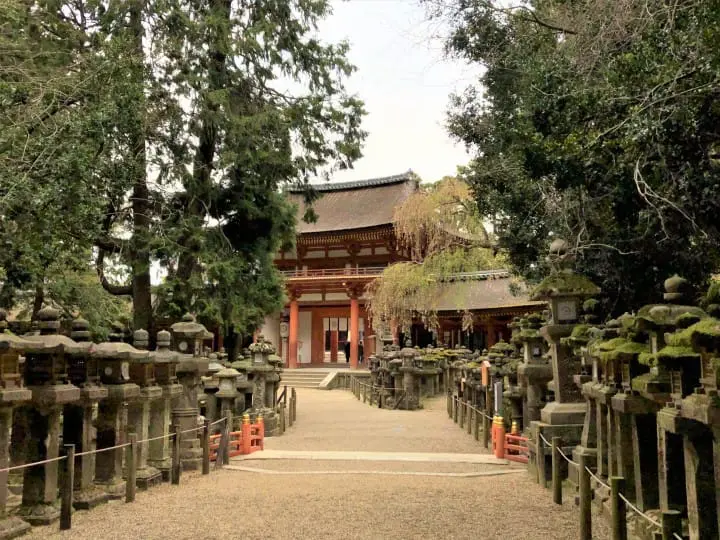
The earthen road that led to the shrine stretched out before us, wide and empty, and the famous deer of Nara Park rested in groups beneath the trees.
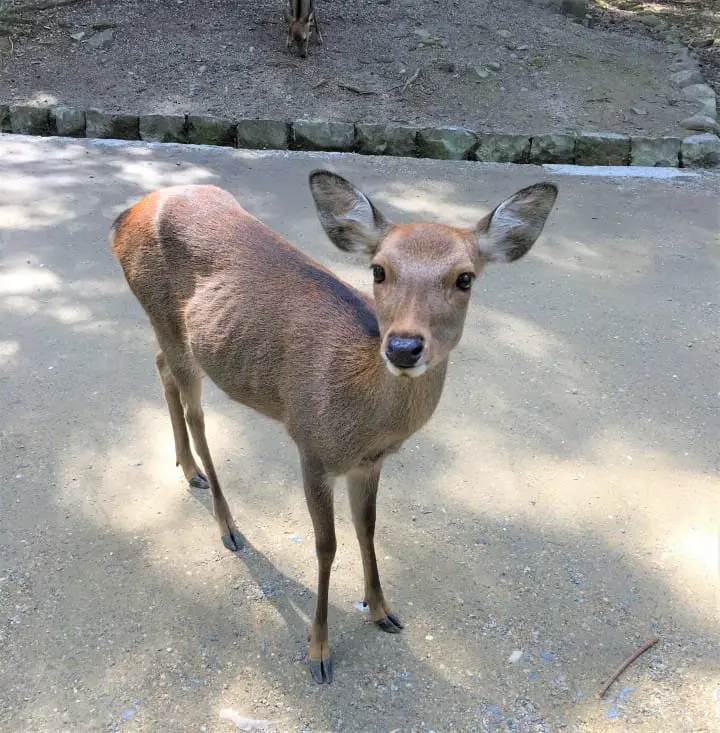
For centuries, the deer were considered sacred, and they have no fear of humans. Carts and vendors throughout Nara Park sell shika senbei (deer crackers) so visitors can feed the deer, but we arrived so early that the carts weren’t open. We gave the deer a scratch behind the ears instead.

Hundreds of carved stone toro (lanterns) stood beside the broad, tree-lined approach to the main shrine yard. Most of these lanterns are several centuries old, and all were donated to the shrine by worshippers, including famous samurai. It was easy to imagine the shrine approach illuminated by the glow of lanterns on a misty evening, centuries ago.

Our choice to visit early in the morning meant we had the shrine almost completely to ourselves, which heightened both our sense of reverence and our ability to appreciate the long, deep history of this holy shrine.
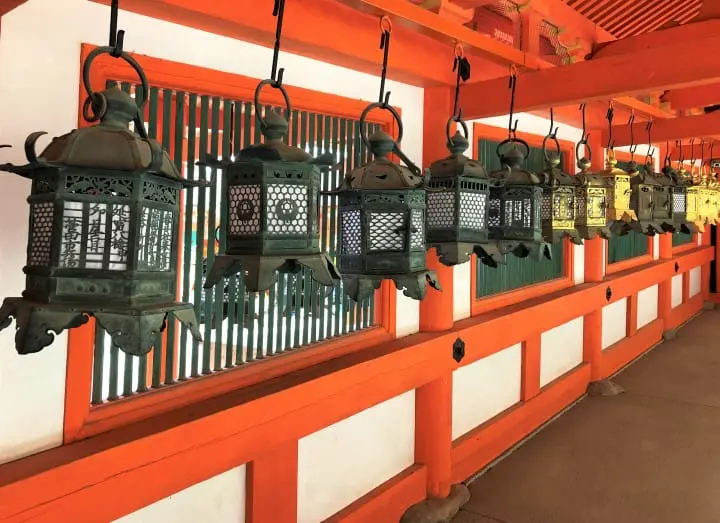
It also gave us extra time to enjoy the massive two-story entrance gate, the massive sacred cedar in the yard, and the many hanging lanterns in the cloisters before the crowds arrived.
Cherry Blossoms and Mt. Wakakusa

At the café adjacent to Kasuga Shrine, my friend and I bought seasonal sakura (cherry blossom) flavored soft serve cones. As we ate, we walked beneath the trees of Nara Park to the trailhead of Wakakusayama (Mt. Wakakusa), a sacred mountain near the shrine.
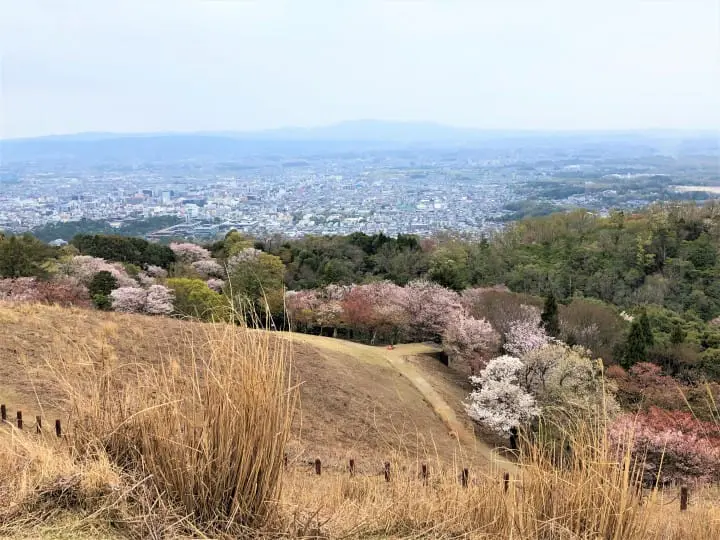
We paid the entrance fee—300 yen (about 3 USD)—at the gate and started up the mountain. The cloudy sky kept the temperature cool as we made the 30-minute climb up wooden stairs and grassy slopes to the summit.
From the engraved summit stone, we looked out over Nara City and at the blooming cherry trees that lined the mountain’s lower slopes.
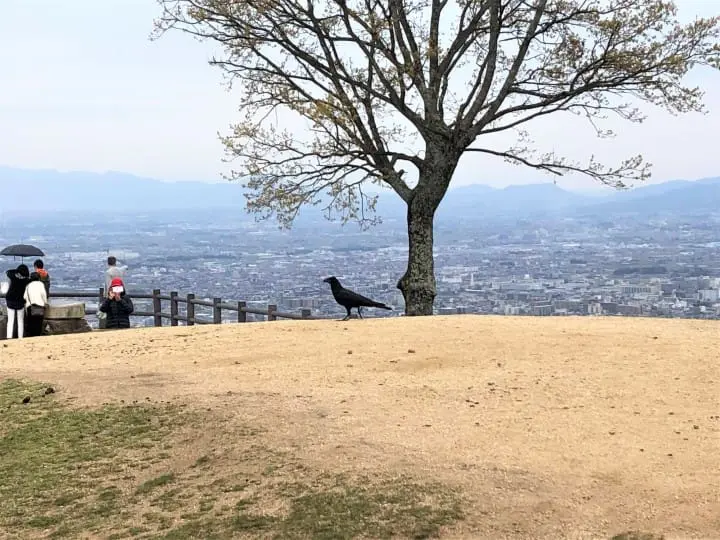
A herd of deer had stopped to eat and rest in the little grassy summit park. Nearby, an enormous crow strutted across the mountaintop like an emperor surveying his domain.
I felt the first few scattered raindrops as we started our descent, which made me glad our next destination—the Daibutsuden (Great Buddha Hall) at Todaiji Temple—had a roof.
Visiting the Great Buddha at Todaiji
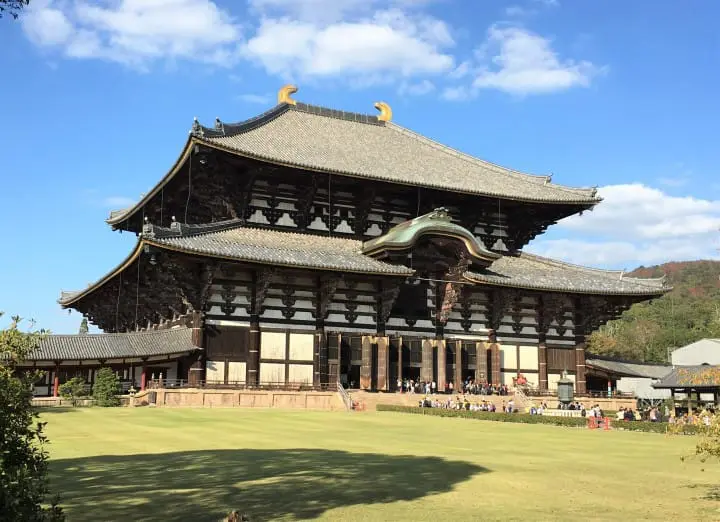
More raindrops pattered the ground as my friend and I crossed the wide, grassy expanse of Nara Park and passed through the gauntlet of deer that roam the stone-paved approach to Todaiji, a Buddhist temple founded during the early 8th century. The temple, which is also a UNESCO World Heritage Site, is home to the Daibutsu, one of the largest bronze Buddha statues in Japan.
We passed through the mammoth wooden Nandaimon (Great South Gate), which rises over 25 meters high and houses the largest wooden guardian statues in Japan. When we emerged on the other side, we needed umbrellas for the final walk to the Buddha Hall.
The Great Buddha Hall of Todaiji is the largest wooden structure in the world. It measures 57 meters wide by almost 50 meters tall—and yet, even at that size, it’s 40% smaller than the original Great Buddha Hall, which was destroyed by fire in 1180, rebuilt, and burned again in 1567.

We marveled at the hall (which I still find impressive, even after a dozen visits) and went inside to view the massive bronze statue of Vairocana, the Buddha of Celestial Light. The Daibutsu measures 15 meters high and dates to the mid-8th century. In addition to walking all the way around the enormous Buddha, we enjoyed the other exhibits inside the hall, which include scale models of the earlier, larger versions of the Buddha Hall.
Although we had to hurry back to the station to catch an afternoon train, my friend and I both thoroughly enjoyed our day in Nara—on and off the beaten path.
Text and photos by Susan Spann
Susan Spann is the author of the Hiro Hattori mystery novels. She lives in Tokyo, but frequently travels across Japan, climbing mountains and seeking adventures off the beaten path. You can find her online at www.susanspann.com.
Susan Spann is the author of the Hiro Hattori mystery novels. She lives in Tokyo, but frequently travels across Japan, climbing mountains and seeking adventures off the beaten path. You can find her online at www.susanspann.com.









































![[2026] Top 5 Strawberry Picking Spots in Tokushima, Naruto| Farms and Access Guide for January to May](https://resources.matcha-jp.com/resize/720x2000/2025/03/06-227165.webp)
![[Yamanashi/ Hokuto City] 4 Hot New Spots Opening in 2026](https://resources.matcha-jp.com/resize/720x2000/2025/12/12-252747.webp)


